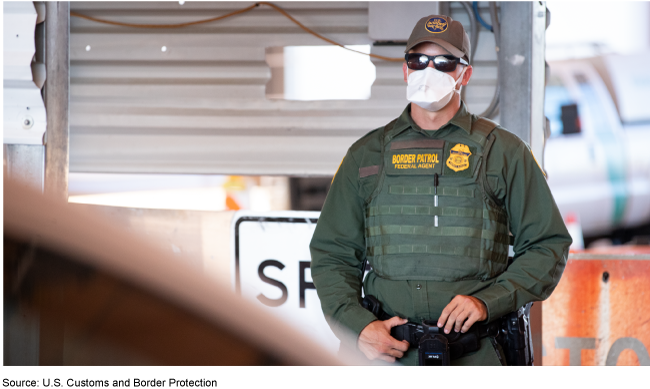Border Security: CBP's Response to COVID-19
Fast Facts
We reviewed U.S. Customs and Border Protection operations during the COVID-19 pandemic.
- Through Feb. 2021, over 7,000 of its employees reported being infected with COVID-19, and 24 died
- Over 20,000 employees were unable to work at some point due to COVID-19-related illness or quarantine
- Employee absences didn't generally have a significant impact at air, land, or sea ports, which saw declining traffic, officials told us
- Absences did affect some Border Patrol operations
- CBP implemented policies intended to protect employees and the public, and adjusted operations, such as by moving some processing activities outdoors

Highlights
What GAO Found
According to data from the Department of Homeland Security's U.S. Customs and Border Protection (CBP), through February 2021, over 7,000 Office of Field Operations (OFO) and U.S. Border Patrol employees reported being infected with COVID-19, and 24 died due to COVID-19-related illnesses. In addition, over 20,000 OFO and Border Patrol employees were unable to work at some point due to COVID-19-related illnesses or quarantining in the same time period. OFO officials noted that employee absences due to COVID-19 did not generally have a significant impact on port operations, given relatively low travel volumes. In contrast, officials interviewed by GAO at three of four Border Patrol locations said that COVID-19 absences had impacted operations to some extent.
COVID-19 Cases within Customs and Border Protection, through February 2021

CBP regularly updated guidance, used workplace flexibilities, and implemented safety precautions against COVID-19. Between January and December 2020, CBP updated guidance on COVID-19 precautions and how managers should address possible exposures. CBP also used a variety of workplace flexibilities, including telework and weather and safety leave to minimize the number of employees in the workplace, when appropriate. Meanwhile, CBP field locations moved some processing functions outdoors, encouraged social distancing, and provided protective equipment to employees and the public. In addition, some field locations took steps to modify infrastructure to prevent the spread of COVID-19, such as installing acrylic barriers or improving airflow in facilities. Challenges implementing operational changes included insufficient equipment for telework at three field locations, and shortages of respirators at a quarter of the ports of entry GAO contacted.
CBP adjusted operations in response to COVID-19 and executive actions. As travel and trade volumes declined, some ports of entry reallocated personnel to other operations, such as cargo processing. In contrast, starting in May 2020 Border Patrol encounters with noncitizens steadily increased. As a result, Border Patrol requested additional resources. It also shifted its deployment strategy to operate as closely to the border as practical to intercept individuals who could be infected with COVID-19. Accordingly, some Border Patrol sectors modified interior operations, such as limiting resources at immigration checkpoints. CBP also assisted in implementing a Centers for Disease Control order that provided the ability to quickly expel apprehended individuals.
Why GAO Did This Study
The COVID-19 pandemic impacted nearly all aspects of society, including travel to and from the U.S. In response to COVID-19, the administration issued executive actions with the intention of decreasing the number of individuals entering the U.S. and reducing transmission of the virus. Within CBP, OFO is responsible for implementing these actions at ports of entry through which travelers enter the U.S., and Border Patrol is responsible for patrolling the areas between ports of entry to prevent individuals and goods from entering the U.S. illegally. Based on their role in facilitating legitimate travel and trade and securing the borders, CBP employees risk exposure to COVID-19 in the line of duty.
GAO was asked to review how CBP managed its field operations in response to the COVID-19 pandemic. This report describes: (1) available data on the number of CBP employees diagnosed with COVID-19 and unable to work; (2) actions CBP has taken related to protecting its workforce and the public from COVID-19; and (3) the extent to which CBP adjusted operations in response to the pandemic and related travel restrictions. GAO reviewed key guidance documents and analyzed data on travel and trade at ports of entry, Border Patrol enforcement, and COVID-19 exposures among CBP employees. GAO also interviewed officials at CBP headquarters, employee unions' representatives, and 12 CBP field locations, selected for factors such as geographic diversity, traffic levels, and COVID-19 infection rates.
For more information, contact Rebecca Gambler at (202) 512-8777 or GamblerR@gao.gov.
